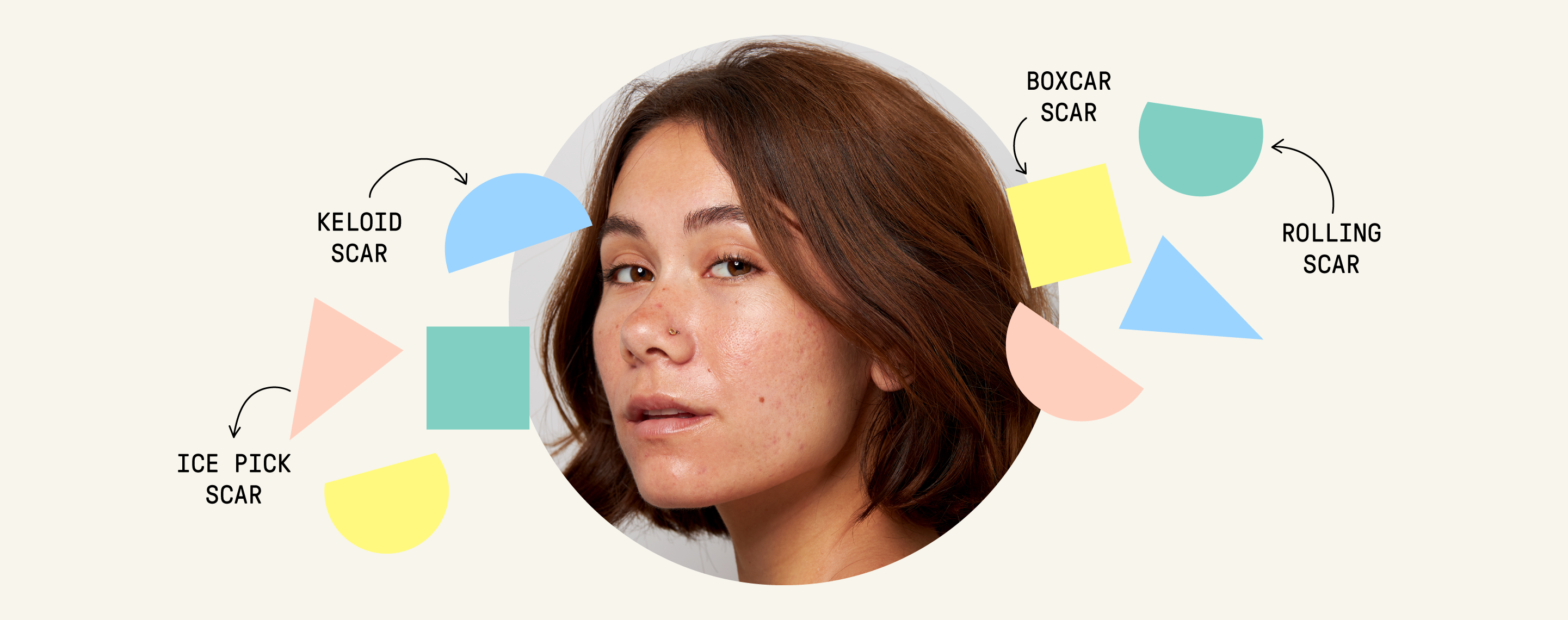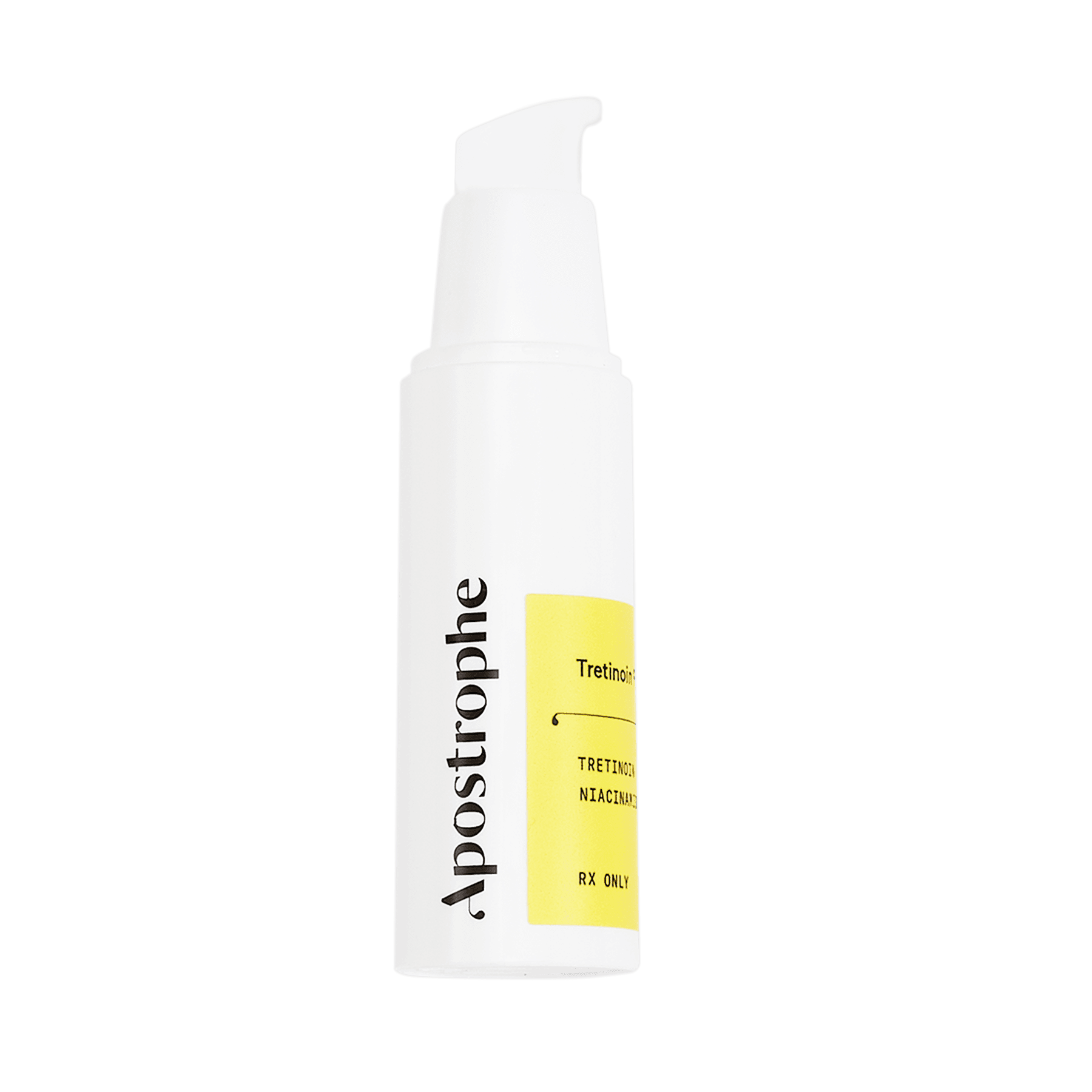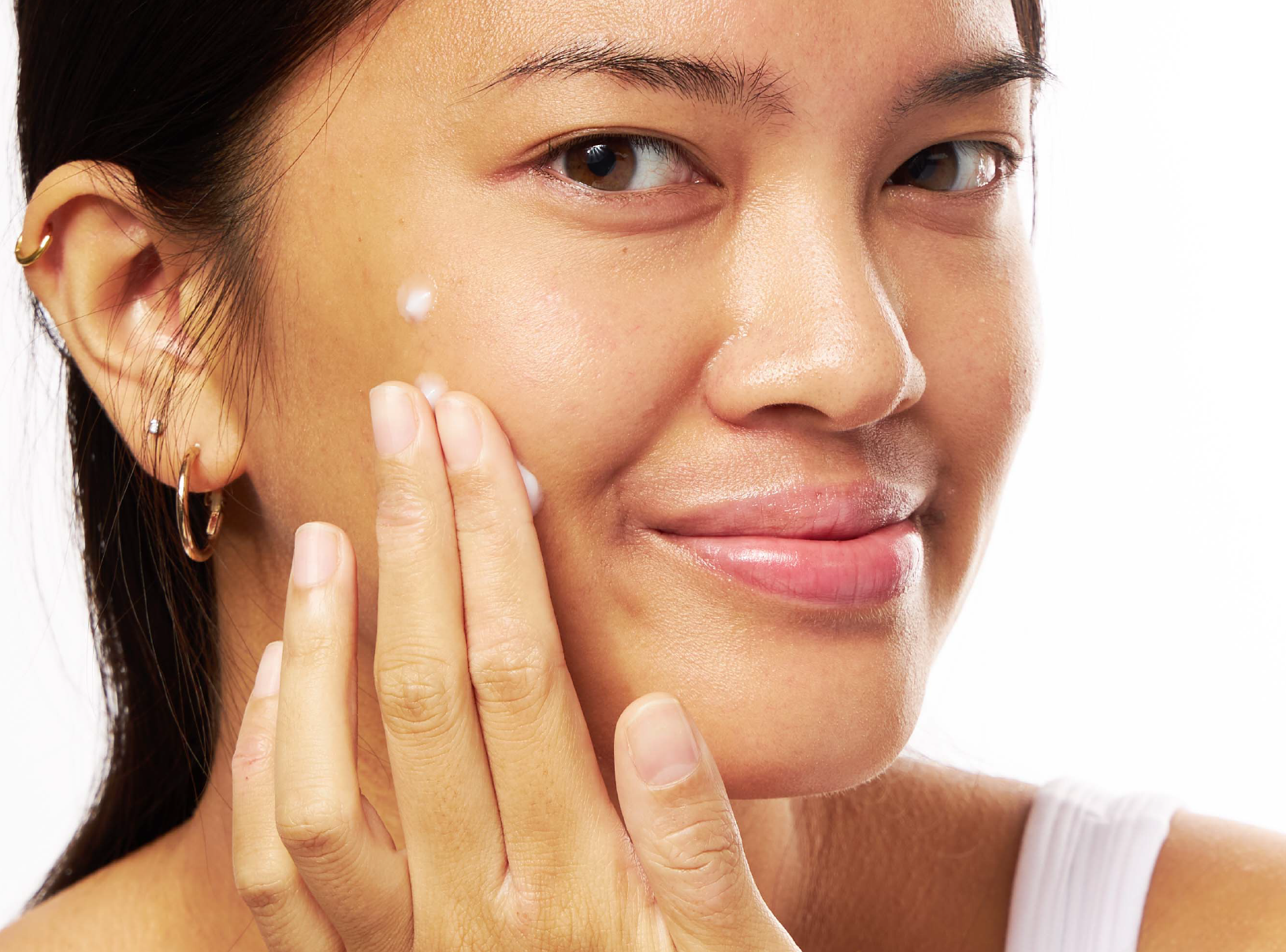Deep Dives
Tretinoin Cream for Acne Scars: Does It Help?


SHARE
Deep Dives
Tretinoin Cream for Acne Scars: Does It Help?
Medically reviewed by Aimee Paik, MD
Written by Apostrophe Team
Last updated 8/1/2024
Dealing with acne can be a frustrating experience. Dealing with the aftermath of severe acne -- scarring, roughness and other skin imperfections -- can often be even harder.
Acne breakouts happen when your hair follicles, or pores, become clogged with debris. When bacteria grow inside these clogged pores, it can often lead to inflamed, painful acne that may leave behind scarring.
Tretinoin is one of the most popular and effective medications for treating acne breakouts and skin aging. But did you know that it’s also a highly effective treatment for many common forms of acne scarring?
Below, we’ve explained how acne develops, as well as why some forms of acne leave behind scars. We’ve also discussed how tretinoin can treat common forms of acne scarring and give your skin back the smooth texture it had prior to your breakouts.
Finally, we’ve shared a few simple techniques that you can use to avoid acne scars and other forms of skin damage in the first place.
What Causes Acne?
Acne develops when your hair follicles become clogged with debris -- typically a mix of sebum and dead skin cells.
Sebum is a type of oil that’s secreted by your sebaceous glands. It plays a key role in keeping your skin lubricated and maintaining your skin’s protective barrier function against germs and other pathogens.
Dead skin cells are produced as a byproduct of epidermal turnover -- a process through which your skin creates new cells to replace old, damaged ones.
Acne can vary in severity. When your hair follicles become clogged with sebum and dead skin cells, comedonal acne can develop. Blackheads and whiteheads are both forms of comedonal acne.
More severe forms of acne, such as inflammatory acne and cystic acne, appear when bacteria multiply inside a clogged pore, causing it to become inflamed and painful.
How Do Acne Scars Develop?
Acne scars form as a result of your body’s response to acne. When a clogged pore turns into an infected acne lesion, it can become inflamed. This is where the red, swollen appearance of acne nodules and cysts comes from.
Most of the time, acne heals without leaving behind any scarring. However, when acne develops deeper inside your skin, it can harm the skin and surrounding tissue, leaving your body to repair the skin during the healing process.
Your skin repairs itself through the creation of collagen -- a structural protein that gives your skin support. Acne scars form when local collagen production either exceeds or matches that of the surrounding skin.
When your body produces excess collagen to repair the skin, it can produce a slight elevation in the new skin tissue. This can result in bumpy, uneven scarring.
When your body produces too little collagen, it can result in tissue loss that creates depressions in your skin. This can result in the classic “icepick” or “boxcar” scars that often appear after acne breakouts.
Types of Acne Scars
Although many people think of all acne scars as, well, acne scars, there are actually four distinct types of scarring that can develop after acne breakouts, each with a different cause and look
Icepick scars. Icepick scars are atrophic scars that tend to be deep and narrow, with the shape of a mark left behind by an icepick. Approximately 60 to 70 percent of all atrophic acne scars are icepick scars.
Boxcar scars. Boxcar scars are wider, round-to-oval shaped atrophic scars. They can range in depth from just over 1mm to 4mm. Boxcar scars make up 20 to 30 percent of atrophic acne scars.
Rolling scars. Rolling scars are wider and smoother than other forms of acne scarring, with an undulating appearance. Rolling scars make up approximately 15 to 25 percent of atrophic acne scars.
Keloid scars. Keloid scars are enlarged, raised scars that may be pink, red or the same color as a person’s natural skin tone. Smaller raised scars that do not extend beyond the acne lesion’s original borders are referred to as hypertrophic scars.In some cases, keloid scars may have a dark color that makes them more visible against a person’s normal skin.
You can learn more about each type of acne scarring and its visible features in our full guide to types of acne scars.
Each type of acne scarring is treated slightly differently. If you have acne scarring, it’s usually a good idea to talk to a dermatology provider to learn more about the type of scarring you have and how you can treat it most effectively.
How Does Tretinoin Work for Acne Scars?
Tretinoin is a skin care medication. It belongs to a class of drugs called topical retinoids and is generally used to treat acne breakouts and reduce the appearance of wrinkles, age spots and other common signs of skin aging.
Topical tretinoin works by stimulating skin cell turnover. When you use tretinoin, your skin cells are created at a faster rate and shed from your skin via a process called exfoliation.
Although tretinoin was originally developed as a treatment for acne, several studies suggest that it can also help to heal acne scars. This may be because of tretinoin’s effects on skin cell growth and the production of collagen -- an important protein for your skin.
Over the last few decades, several studies have looked into the effects of tretinoin on acne scar visibility.
In a 2004 study, researchers used topical tretinoin on 38 patients -- 29 women and 9 men -- with some level of acne scarring. The patients ranged in age from 16 to 29 and took part in the study over a period of three and a half months on average.
The researchers found that when the subjects used tretinoin cream for acne scars consistently, 79 percent of the participants showed flattened acne scarring. The treatment was most effective on younger acne scars, as well as with narrow, indented icepick scars.
The researchers concluded that treating acne scars with tretinoin could potentially replace more invasive techniques, such as dermabrasion or chemical peels, or be useful as a complementary medication alongside other acne scar treatments.
Another study of tretinoin by iontophoresis for acne scars produced similar results. In this 1999 study, 32 volunteers with acne scars had 0.025% tretinoin gel along with an iontophoresis device applied twice weekly to areas with acne scarring.
After three months, 94 percent of the patients experienced a significant decrease in the depth of their acne scars. The researchers concluded that tretinoin is an “effective, noninvasive treatment of atrophic acne scars without causing disturbing side-effects.”
A review of treatments for acne scarring also mentions tretinoin, although not as a treatment for scars. Instead, it mentions that tretinoin is often used as a form of pre-treatment for other acne scar treatments, such as medium and deep chemical peeling.
Finally, studies of other retinoids (the class of medications to which tretinoin belongs) also show positive results in treating acne scarring. In one 2015 study, people with acne scarring noticed a significant improvement in acne scarring after using a mix of retinoic and glycolic acid.
How to Use Tretinoin for Acne Scarring
Applying tretinoin is a simple process. Topical tretinoin is available as a cream, gel or liquid, all of which can be applied directly to acne-affected skin. It’s also one of several active skin care ingredients in our Customized Acne Cream.
Our complete guide to using tretinoin for acne discusses the entire process of using tretinoin for acne prevention or acne scar healing.
To get the best results from tretinoin for acne scar flattening, removal or healing, use the tactics and tips below:
Wash your face and hands before you begin. Make sure that your face and hands are completely clean before using tretinoin. Use warm water and bland, mild soap and allow 20 to 30 minutes for your face to dry before applying tretinoin cream, gel or liquid.
Start with a low to moderate strength of tretinoin. Tretinoin comes in several different concentrations. To minimize irritation and other side effects, consider starting with a mild tretinoin product.
Only use as much tretinoin as needed. More tretinoin doesn’t necessarily mean better results. Use enough medication to apply a thin layer to your skin. Most of the time, you won’t need to use more than a pea-sized amount of tretinoin cream.
Reduce your sun exposure while using tretinoin. Tretinoin can make your skin more sensitive to sunlight. Avoid bright daytime sun and use sun protection, such as an SPF 30+ sunscreen and sunglasses, while you’re using tretinoin to treat acne scars.
Consider using a moisturizer with tretinoin. Tretinoin may cause your skin to become dry and irritated, especially if you have sensitive skin. To prevent unwanted dryness, try applying moisturizer before using tretinoin and other topical treatments.
Be prepared for the tretinoin purge. During the first few weeks of treatment, it’s quite common for your skin to look slightly worse before it gets better. During this period, you may notice mild acne, skin irritation and other adverse effects.
Have realistic expectations. While tretinoin might be able to lighten your acne scars, there’s no guarantee that it will fully remove them. Have realistic expectations of what tretinoin can and can’t do and you’ll likely be more satisfied with your results.
Understand that results take time. Tretinoin works, but results aren’t immediate. You may need to use tretinoin for several weeks before you’re able to see improvements in your skin’s texture, tone and general appearance.
How to Prevent Acne Scars
Although tretinoin is great at getting rid of acne scars, the best way to deal with acne scarring is to prevent it from developing in the first place. Try the following tips and skin care techniques to stop breakouts and keep your skin free of scarring:
Treat acne before it becomes severe. The longer you wait to treat acne, the greater your risk of developing scarring. Try to treat your acne breakouts as soon as you first notice them, before your acne has a chance to become more severe.
For severe acne, consider an antibiotic. Antibiotics such as clindamycin and doxycycline are often used to help with inflammation and prevent scarring.
Avoid popping or picking at your acne. While it might feel tempting to pop pimples, doing so isn’t a good idea. Popping acne can increase your risk of developing scarring and infections. Instead, try treating your acne with topical acne treatments.
Continue treating acne after it clears. Acne treatment isn’t a one-off thing. In order to maintain clearer skin and prevent future breakouts, it’s important to continue using your acne medication even after your initial breakouts clear.
Avoid scrubbing your skin. Scrubbing your skin can cause irritation and worsen your acne breakouts. Instead of scrubbing your skin, practice gentle skin care by applying acne treatments carefully using your fingertips.
Learn More About Using Tretinoin for Acne
Acne breakouts are a serious annoyance. When they leave behind permanent scars, they can have a serious impact on your appearance and self-confidence.
Thankfully, tretinoin is one of the most powerful and effective medications available for dealing with both acne breakouts and the scarring they can leave behind.
Our guide to tretinoin goes into more detail about how tretinoin works as a treatment for acne, scarring and as a powerful anti-aging medication.
Interested in using tretinoin? You can access tretinoin and other science-based ingredients for maintaining healthy skin with our Customized Acne Cream and full range of skin care products.
Cited Sources:
Hoover, E., Aslam, S. & Krishnamurthy, K. (2020, October 26). Physiology, Sebaceous Glands. StatPearls. Retrieved from https://www.ncbi.nlm.nih.gov/books/NBK499819/
Koster, M.I. (2009, July). Making an epidermis. Annals of the New York Academy of Sciences. 1170, 7–10. Retrieved from https://www.ncbi.nlm.nih.gov/pmc/articles/PMC2861991/
Acne. (n.d.). Retrieved from https://www.americanskin.org/resource/acne.php
Acne Scars: Who Gets and Causes. (n.d.). Retrieved from https://www.aad.org/public/diseases/acne/derm-treat/scars/causes
Connolly, D., Vu, H.L., Mariwalla, K. & Saedi, N. (2017, September). Acne Scarring—Pathogenesis, Evaluation, and Treatment Options. The Journal of Clinical and Aesthetic Dermatology. 10 (9), 12–23. Retrieved from https://www.ncbi.nlm.nih.gov/pmc/articles/PMC5749614/
Yoham, A.L. & Casadesus, D. (2020, December 5). Tretinoin. StatPearls. Retrieved from https://www.ncbi.nlm.nih.gov/books/NBK557478/
Knor, T. (2004). Flattening of atrophic acne scars by using tretinoin by iontophoresis. Acta Dermatovenerologica Croatica. 12 (2), 84-91. Retrieved from https://pubmed.ncbi.nlm.nih.gov/15075042/
Schmidt, J.B., et al. (1999, February). Tretinoin-iontophoresis in atrophic acne scars. International Journal of Dermatology. 38 (2), 149-53. Retrieved from https://pubmed.ncbi.nlm.nih.gov/10192170/
Kravvas, G. & Al-Niaimi, F. (2017, March 30). A systematic review of treatments for acne scarring. Part 1: Non-energy-based techniques. Scars, Burns & Healing. 3. Retrieved from https://journals.sagepub.com/doi/full/10.1177/2059513117695312
Chandrashekar, B.S., Ashwini, K.R., Vasanth, V. & Navale, S. (2015, March-April). Retinoic acid and glycolic acid combination in the treatment of acne scars. Indian Dermatology Online Journal. 6 (2), 84-88. Retrieved from https://www.ncbi.nlm.nih.gov/pmc/articles/PMC4375771/
Tretinoin Topical. (2019, March 15). Retrieved from https://medlineplus.gov/druginfo/meds/a682437.html
Pimple Popping: Why Only a Dermatologist Should Do It. (n.d.). Retrieved from https://www.aad.org/public/diseases/acne/skin-care/popping
Acne Scars: Self-Care. (n.d.). Retrieved from https://www.aad.org/public/diseases/acne/derm-treat/scars/self-care
Bradford, K (2020) Retrieved from https://familydoctor.org/condition/keloids/
This article is for informational purposes only and does not constitute medical advice. The information contained herein is not a substitute for and should never be relied upon for professional medical advice. Always talk to your doctor about the risks and benefits of any treatment.
Shop this post

Topical Retinoids
Like what you just read? Sign up for our email list to get the scoop on skincare science delivered straight to your inbox.

Deep Dives
A dermatologist shares his thoughts on the recent studies about benzoyl peroxide and benzene.
Read More
Education
What is milia?
What is milia? Today, we’re jumping into one type of bump that you may have heard about most commonly in infants — milia.
Read More
Education
Best moisturizer for acne-prone skin
If you have combination acne-prone skin, figuring out which moisturizer is best for your skin might be tough. In this guide, we break down the best moisturizer for combination, acne-prone skin.
Read More
